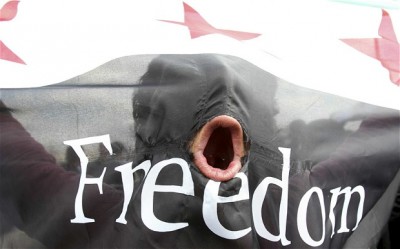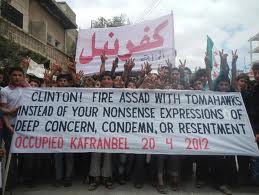 By WP Editorial Board
By WP Editorial Board
THE ONLY good news about Syria since the Obama administration’s embrace of an unworkable United Nations peace plan is the hints that it is beginning to consider alternatives. Adopted a month ago by the Security Council, the six-point “Annan plan” has not been observed in any respect by the regime of Bashar al-Assad — an outcome that was entirely predictable, and that has led to the deaths of more than 1,000 more people.
Mr. Assad will never be induced by diplomacy to end his assaults on Syrian cities, allow peaceful demonstrations or release political prisoners, because he is unwilling to leave power or allow his regime to collapse. Good-faith efforts by U.N. envoys, like those of the Arab League and Turkey before them, merely provide cover for his brutality.
The United States and its NATO allies ought to know from the Arab League’s disastrous monitoring mission in Syria last year that observers will not stop the regime’s violence. They will be hindered and intimidated;
The challenge for the US administration is to recognize these realities and embrace options that actually can advance its stated goal of ending Mr. Assad’s rule.
So far that’s not happening. Secretary of State Hillary Rodham Clinton told a meeting of foreign ministers Thursday that she remained “hopeful that, despite the evidence thus far, the mission of Kofi Annan can begin to take root.” On Saturday the United States voted to support the Security Council’s next step in that initiative — the dispatch of 300 unarmed monitors to “observe” a nonexistent “cease-fire.”
The United States and its NATO allies ought to know from the Arab League’s disastrous monitoring mission in Syria last year that observers will not stop the regime’s violence. They will be hindered and intimidated; the leader of an advance mission has already declared that it will not work on Fridays, when the largest demonstrations take place. By focusing diplomacy and attention on monitoring, Western governments will simply provide Mr. Assad with more time to kill.
 Encouragingly, Ms. Clinton said Thursday that “we have to do more to take tougher actions against the Assad regime.” But her principal idea — a Security Council resolution imposing more sanctions and an arms embargo, is another non-starter. More sanctions won’t stop Mr. Assad, and an arms embargo would only lock in the regime’s advantage over the opposition Free Syrian Army. What’s more, as Ms. Clinton acknowledged, any such resolution “is still likely to be vetoed” by Russia. Even a Western attempt to refer to possible future sanctions in Saturday’s resolution was blocked by Moscow.
Encouragingly, Ms. Clinton said Thursday that “we have to do more to take tougher actions against the Assad regime.” But her principal idea — a Security Council resolution imposing more sanctions and an arms embargo, is another non-starter. More sanctions won’t stop Mr. Assad, and an arms embargo would only lock in the regime’s advantage over the opposition Free Syrian Army. What’s more, as Ms. Clinton acknowledged, any such resolution “is still likely to be vetoed” by Russia. Even a Western attempt to refer to possible future sanctions in Saturday’s resolution was blocked by Moscow.
The measures most likely to be effective in Syria remain near the bottom of the administration’s list. Ms. Clinton mentioned the possibility that Turkey, a NATO member, would invoke the alliance’s Article 4, which requires consultation when the territory or security of a member is threatened. Syrian forces have fired across the Turkish border, where thousands of refugees have gathered. Any resulting consultations should focus on proposals, floated by both Turkey and France, for the creation of a safe zone or humanitarian corridor on Syrian territory — a step that could be accomplished with a modest military force and could cause the regime to collapse.
By focusing on diplomacy and attention on monitoring, Western governments will simply provide Mr. Assad with more time to kill.
Ms. Clinton also mentioned greater support for the opposition, including the creation with Turkey of an “assistance hub.” This would be useful, as promised supplies so far have mostly failed to reach opposition groups. Mr. Assad will fall only when his attacks are blocked and countered; it follows that U.S. policy should aim at that.
Washington Post
Leave a Reply
You must be logged in to post a comment.